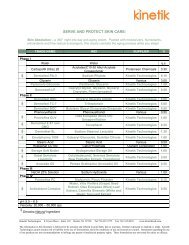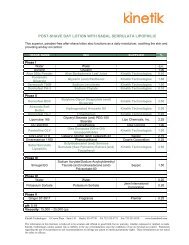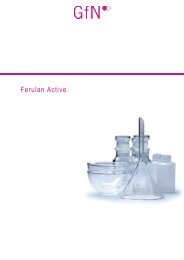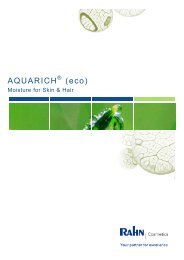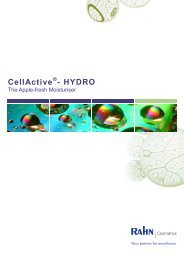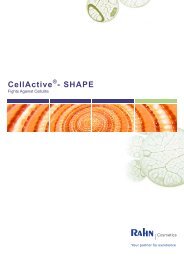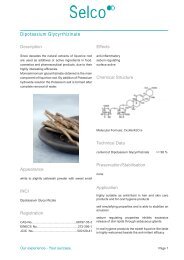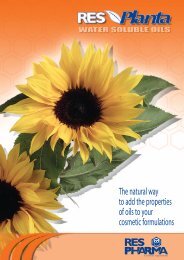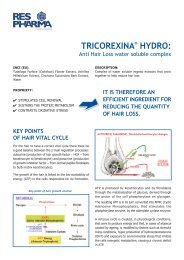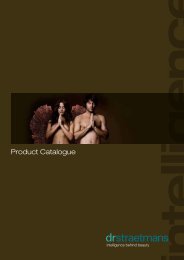HYDRACTIN Moisture & Energy - Kinetik
HYDRACTIN Moisture & Energy - Kinetik
HYDRACTIN Moisture & Energy - Kinetik
Create successful ePaper yourself
Turn your PDF publications into a flip-book with our unique Google optimized e-Paper software.
<strong>HYDRACTIN</strong> ®<br />
<strong>Moisture</strong> & <strong>Energy</strong>
Table of contents<br />
1 Introduction 3<br />
2 Active Principle 4<br />
2.1 The Stratum Granulosum 5<br />
2.2 Supply of Active Substances 6<br />
2.3 Biopolymers from Algae 7<br />
2.4 <strong>HYDRACTIN</strong> ® , a Concept 7<br />
3 Efficacy Tests 8<br />
3.1 Immediate Skin Moisturization 8<br />
3.2 Long-term Moisturization 9<br />
4 Use and Storage 10<br />
4.1 Summary 10<br />
4.2 Areas of Use 10<br />
4.3 Origin of the Substances 10<br />
4.4 Suggestions for Storage 10<br />
4.5 Suggestions for Use 10<br />
4.6 Suggested Usage Concentrations 10<br />
5 Specification 11<br />
5.1 Product Specification 11<br />
6 Registration and Description 12<br />
6.1 INCI Name 12<br />
6.2 Registration and Contents 12<br />
6.3 Other Substances 12<br />
7 Toxicology and Safety Assessment 13<br />
7.1 Toxicology 13<br />
7.2 Environmental Toxicology 13<br />
7.3 Water Hazard Class 14<br />
7.4 Safety Assessment 14<br />
8 Test Emulsions and their Effects 15<br />
8.1 Product Description 15<br />
8.2 Recipe DAY 0403 15<br />
8.3 Production of Emulsion 16<br />
8.4 Stability Data 16<br />
8.5 Efficacy of Cream M/11 and DAY 0403 17<br />
8.6 Summary 18<br />
9 Bibliography 19<br />
Seite 2 / 20<br />
<strong>HYDRACTIN</strong> ® │ <strong>Moisture</strong> & <strong>Energy</strong>
1 Introduction<br />
The skin makes use of a sophisticated defense system in order to protect itself from adverse<br />
influences and from excessive loss of moisture.<br />
The multi-layered membrane which is responsible for hindering almost all loss of water from the<br />
skin and the intrusion of chemicals is not located at the the skin’s surface. It is located within the<br />
lower levels of the corneal layer (Stratum corneum).<br />
The tissues located below this membrane contain most of the skin's moisture. The water content of<br />
these cells is around 70-80%. The moisture content of the corneal layer at 10%, is significantly<br />
lower. The outer part of the corneal layer only contains 2% water.<br />
As the smoothness and consequently the appearance of the skin depend on the presence of<br />
sufficient amounts of water, the ability to keep the moisture level within the corneal layer is of<br />
paramount physiological importance. Whenever the corneal layer dries out, it becomes brittle and<br />
looses elasticity. The substances which, in conjunction with water, build a nearly water-resistant<br />
multi-layered barrier become brittle as the water content diminishes. This process leads to an<br />
increase of water permeability. This effect can be compensated by adding moisture but not by<br />
adding fatty substances. Therefore, it is necessary to provide the corneal layer with active cosmetic<br />
substances that are able to overcome deficiencies as well as able to activate the biochemical<br />
processes.<br />
<strong>HYDRACTIN</strong> ® is now available to the cosmetics industry. This product is an innovative active<br />
ingredient which can intensively moisturise dry skin with a long lasting effect.<br />
Seite 3 / 20<br />
<strong>HYDRACTIN</strong> ® │ <strong>Moisture</strong> & <strong>Energy</strong>
2 Active Principle<br />
The corneal layer (Stratum corneum) plays a fundamental role in regulating the skin’s moisture<br />
level. The corneal layer is the upper outside layer of the epidermis, and thus builds a protective<br />
layer. The hardened keratinized cells and the barrier lipids build a brick wall type of structure that<br />
protects the skin from invading foreign substances and prevents water from the inside to<br />
evaporate. This barrier is thus a vital area whose roles are protecting the skin and keeping it<br />
healthy.<br />
Area of activity<br />
<strong>HYDRACTIN</strong> ®<br />
The vital role played by the corneal layer in regulating skin moisture raises the question of how to<br />
influence the formation of the corneal layer itself in a positive way.<br />
The most important steps in building the corneal layer take place within the layer below, that is the<br />
granular layer (Stratum granulosum). Therefore, it is important to understand that layer better.<br />
Seite 4 / 20<br />
<strong>HYDRACTIN</strong> ® │ <strong>Moisture</strong> & <strong>Energy</strong>
2.1 The Stratum Granulosum<br />
This layer is the location of many rapid metabolic processes. It is within this layer that cell formation<br />
and cell death take place. The densely built corneal layer results from the transformation of cells of<br />
the epidermis containing water while building and excreting barrier lipids As a result, the cell<br />
structure changes into rigid, flattened keratin filaments.<br />
In order to carry out such complex metabolic processes, large amounts of energy are required.<br />
<strong>Energy</strong> is available primarily from the most powerful chemical entity of cell metabolism, adenosine<br />
triphosphate (ATP).<br />
ATP ADP + P + <strong>Energy</strong> (approx. 30kJ/mol)<br />
ATP is broken up into adenosine diphosphate (ADP) and energy, and in a subsequent step even<br />
into adenosine monophosphate (AMP). Similarly, as with batteries, both ADP and AMP are<br />
charged to ATP within the mitochondria, the energy generators within the cell.<br />
Impressive in-vivo studies by K. Schrader and S. Bielfeldt demonstrated that a lotion containing<br />
ATP applied to the skin significantly increases both the long-term and the short-term moisture<br />
retention capability of the skin. In addition, a considerable improvement in skin texture was<br />
achieved, probably due to an increase in moisture in the skin. In that study, the increase of skin<br />
moisture could clearly be attributed to the activation of biochemical processes. However, the<br />
individual reactions involved not elucidated.<br />
Structure of the ATP molecule<br />
Seite 5 / 20<br />
<strong>HYDRACTIN</strong> ® │ <strong>Moisture</strong> & <strong>Energy</strong>
2.2 Supply of Active Substances<br />
A complete woman's face cleansing includes weekly peeling. Most men are unaware of the fact<br />
that this type of removal of detached keratinocytes occurs while shaving. Razors used for both dry<br />
andwet shaving do remove the cells of the corneal layer, thus resulting in a soft peeling.<br />
Keratinolytics are substances which aid the softening and detaching of flat fused cells, thus<br />
enabling active substances and skin care substances to access the inside of the skin. A uniform<br />
skin surface lets the skin appear fresh and smooth.<br />
The Papaya fruit contains the enzyme papain and extraordinarily high amounts of vital substances<br />
such as beta carotene and vitamins as well as glucosides and trace elements. Papain is a<br />
particularly mild keratinolytic. In fact, as opposed to fruit acids, papain is already active at neutral<br />
pH values. It fosters the access of active substances to the skin and of skin care substances<br />
through a particularly soft peeling effect without causing skin irritation. The skin obtains new<br />
freshness and an attractive appearance.<br />
Seite 6 / 20<br />
<strong>HYDRACTIN</strong> ® │ <strong>Moisture</strong> & <strong>Energy</strong>
2.3 Biopolymers from Algae<br />
In order to complete the <strong>HYDRACTIN</strong> ® moisturizing concept, a polysaccharide from the brown<br />
algae is added. It builds a thin film on the skin which reduces the loss of moisture. Due to its size,<br />
this biopolymer cannot penetrate the skin. However, it builds a soft net-like protecting film which<br />
reduces the natural evaporation of water from the skin.<br />
2.4 <strong>HYDRACTIN</strong> ® , a Concept<br />
<strong>HYDRACTIN</strong> ® is an optimized system for the physical and biochemical support of the skin.<br />
All substances included in this system are of natural origin and have been scientifically tested as to<br />
their efficacy and safety. The excellent efficacy of <strong>HYDRACTIN</strong> ® for enhancing skin moisturization<br />
was also demonstrated with an in-vivo study against a placebo involving 16 people. Both the shortand<br />
the long-term moisturizing effects were tested.<br />
<strong>HYDRACTIN</strong> ® is a unique cosmetic active ingredient which is effective on<br />
three levels:<br />
‣ As an energy source stimulating and activating the cellular<br />
metabolism, leading to a significant increase of skin moisture<br />
‣ Reducing trans-epidermal water loss (TEWL)<br />
‣ Vital substances from the papaya provide the skin with new<br />
freshness and beauty<br />
Seite 7 / 20<br />
<strong>HYDRACTIN</strong> ® │ <strong>Moisture</strong> & <strong>Energy</strong>
3 Efficacy Tests<br />
3.1 Immediate Skin Moisturization<br />
The immediate moisturization effect of <strong>HYDRACTIN</strong> ® was tested on 16 people by an independent<br />
laboratory. Test emulsion M/10 (without <strong>HYDRACTIN</strong> ® ), M/11 (with 3% <strong>HYDRACTIN</strong> ® ) and DAY<br />
0403 (with 6% <strong>HYDRACTIN</strong> ® ) were applied to the skin. The moisture level of the skin was<br />
measured with a corneometer after 0, 1, 3, and 5 hours.<br />
The diagram depicts the percentage increase of skin moisture against a placebo for<br />
<strong>HYDRACTIN</strong> ® at concentrations of 3% and 6%.<br />
The measurement at hour zero indicates the skin moisture level before <strong>HYDRACTIN</strong> ® was applied.<br />
After the time intervals of 1, 3, and 5 hours, the values measured with M/10 (placebo) were<br />
deducted from the values measured with <strong>HYDRACTIN</strong> ® in order to obtain the real moisturization<br />
effect of <strong>HYDRACTIN</strong> ® at concentrations of 3% and 6% in the cream.<br />
The increase of moisturization<br />
1 hour after application is:<br />
18% with 3% <strong>HYDRACTIN</strong> ®<br />
and even 39% with 6% <strong>HYDRACTIN</strong> ® !<br />
Seite 8 / 20<br />
<strong>HYDRACTIN</strong> ® │ <strong>Moisture</strong> & <strong>Energy</strong>
3.2 Long-term Moisturization<br />
A long-term study of 16 people was carried out spanning a period of 28 days. Application of the<br />
emulsions M/10, M/11, and DAY 0403 to the skin was repeated daily. On day 28, skin<br />
moisturization was measured with a corneometer 12 hours after the last application.<br />
As above, the diagram depicts the percentage increase of skin moisturization due to <strong>HYDRACTIN</strong> ®<br />
at concentrations of 3% and 6% against a placebo.<br />
The measurement at hour zero indicates the skin moisture level before <strong>HYDRACTIN</strong> ® was applied.<br />
After 28 days, the value measured with M/10 (placebo) was deducted from the values measured<br />
with <strong>HYDRACTIN</strong> ® in order to obtain the real moisturization effect of <strong>HYDRACTIN</strong> ® at<br />
concentrations of 3% and 6% in the cream.<br />
The increase of moisturization<br />
28 days after application is:<br />
11% with 3% <strong>HYDRACTIN</strong> ®<br />
and even 17% with 6% <strong>HYDRACTIN</strong> ® !<br />
The results were obtained 12 hours after<br />
the last application of the test emulsion.<br />
Seite 9 / 20<br />
<strong>HYDRACTIN</strong> ® │ <strong>Moisture</strong> & <strong>Energy</strong>
4 Use and Storage<br />
4.1 Summary<br />
The individual components in <strong>HYDRACTIN</strong> ® are synergistically balanced active substances. They<br />
meet the need for a positive and lasting moisturization of the skin. In addition, the hydrated skin<br />
yields a radiant youthful appearance.<br />
4.2 Areas of Use<br />
♦ Day skin care ♦ Body lotion<br />
♦ Night skin care ♦ Hand care<br />
♦ Moisturizing fluid ♦ After sun products<br />
4.3 Origin of the Substances<br />
<strong>HYDRACTIN</strong> ® is of botanical and biotechnological origin. It does not contain any animal-derived<br />
substances or any substances derived from mineral oils.<br />
4.4 Suggestions for Storage<br />
<strong>HYDRACTIN</strong> ® should be stored at a low temperature (4°C) away from light. Shelf life is 24 month<br />
after production.<br />
4.5 Suggestions for Use<br />
The use of a complexing agent such as EDTA in formulations is recommended. Heavy metals<br />
interfere with both papain and ATP. It is recommended that the pH of the final product is greater<br />
than 6.0, at lower pH conditions ATP is reduced to ADP.<br />
4.6 Suggested Usage Concentrations<br />
2% - 8%<br />
Seite 10 / 20<br />
<strong>HYDRACTIN</strong> ® │ <strong>Moisture</strong> & <strong>Energy</strong>
5 Specification<br />
5.1 Product Specification<br />
Test Parameter Test Equipment Specification Value<br />
Appearance TP 063 Yellowish, almost clear solution<br />
Odor TP 063 Characteristic<br />
Consistency TP 063 Liquid<br />
pH-Value, direct TP 006 6.2 – 7.0<br />
Refraction index 20°C TP 044 1.438 – 1.445<br />
Density 20°C TP 007 1.204 – 1.214 g/ml<br />
Centrifuge TP 042 No visible separation<br />
Total plate count TP 032 < 50 cfu/g<br />
Seite 11 / 20<br />
<strong>HYDRACTIN</strong> ® │ <strong>Moisture</strong> & <strong>Energy</strong>
6 Registration and Description<br />
6.1 INCI Name<br />
EU: Glycerin, Aqua, Disodium Adenosine Trisphosphate, Carica Papaya Fruit Extract, Algin<br />
USA: Glycerin, Water, Disodium Adenosine Trisphosphate, Carica Papaya Fruit Extract, Algin<br />
Japan: Glycerin, Water, Disodium Adenosine Trisphosphate, Carica Papaya Fruit Extract, Algin<br />
6.2 Registration and Contents<br />
INCI EU Content in % CAS-Nr. EINECS-Nr.<br />
Glycerin > 50 56-81-5 200-289-5<br />
Aqua 10 – 25 7732-18-5 231-791-2<br />
Disodium<br />
Adenosine<br />
Triphosphate<br />
1-5 987-65-5 213-579-1<br />
Algin 0.1-1 9005-38-3 Polymer<br />
Carica Papaya Fruit<br />
Extract<br />
0.1-1 84012-30-6 281-675-0<br />
6.3 Other Substances<br />
0.50% Phenoxyethanol is added to preserve <strong>HYDRACTIN</strong> ® .<br />
Seite 12 / 20<br />
<strong>HYDRACTIN</strong> ® │ <strong>Moisture</strong> & <strong>Energy</strong>
7 Toxicology and Safety Assessment<br />
7.1 Toxicology<br />
Test Parameter Test Method Assessment<br />
Oral toxicity Inform. from literature Not toxic *<br />
Skin irritation<br />
Rep. human patch test with 30 people<br />
using 20% aqueous solution<br />
Not irritating<br />
Eye Irritation BECAM test (in-vitro), undiluted Slightly irritating<br />
Sensitization<br />
Photo toxicity<br />
Rep. human patch test with 30 people<br />
using 20% aqueous solution<br />
Photo patch test with 50 people using<br />
20% aqueous solution<br />
Not sensitizing<br />
Not photo toxic<br />
Mutagenicity AMES test (in-vitro), undiluted Not mutagenic<br />
* Oral toxicity is defined as non-toxic based on literature sources that refer to the LD50 for glycerol<br />
of >2 g/kg, for algin of >5 g/kg and for ATP of >0.25 g/kg. The papaya fruit is a foodstuff and thus<br />
not considered toxic. In view of individual usage concentrations, an assessment of non-toxicity is<br />
considered appropriate. However, an exact oral toxicity assessment was not carried out.<br />
7.2 Environmental Toxicology<br />
Test Parameter Test Method Assessment<br />
Biol. Degradability OECD 301 F Readily biodegradable<br />
Daphnia limit test 100 mg/Liter, 48<br />
hours<br />
Not toxic<br />
In all likelihood, <strong>HYDRACTIN</strong> ® will not have any environmental toxicological impact. Its<br />
Bioaccumulation can be ruled out as <strong>HYDRACTIN</strong> ® is soluble in water and biodegradable.<br />
Seite 13 / 20<br />
<strong>HYDRACTIN</strong> ® │ <strong>Moisture</strong> & <strong>Energy</strong>
7.3 Water Hazard Class<br />
Substance Information from Literature Assessment<br />
Glycerol Merck Index WHC 0<br />
Water None WHC 0<br />
ATP Merck Index WHC 1<br />
Algin Information from producer /<br />
research study<br />
WHC 1<br />
Papaya extract none unknown<br />
As the papaya fruit is a foodstuff, its consumption is harmless. Therefore, the addition of papaya<br />
extract is not considered devaluating. The good biological degradability and the non-toxicity as<br />
determined with the Daphnia limit test confirmed these assumptions.<br />
For these reasons, <strong>HYDRACTIN</strong> ® is assessed as a product with the water hazard value 1.<br />
7.4 Safety Assessment<br />
<strong>HYDRACTIN</strong> ® can be classified as harmless based on comprehensive toxicological data and<br />
environmental toxicological information. During testing, neither irritating nor toxic characteristics of<br />
any kind emerged. No single irritation was detected during efficacy testing on 16 people during a<br />
28 day period.<br />
Seite 14 / 20<br />
<strong>HYDRACTIN</strong> ® │ <strong>Moisture</strong> & <strong>Energy</strong>
8 Test Emulsions and their Effects<br />
Efficacy tests were conducted using a light non-fatty base, as required by modern day care<br />
creams. The stability tests and the physical parameters of the test cream DAY 0403 are listed<br />
below.<br />
8.1 Product Description<br />
White emulsion, pH value of 6.7, viscosity of approximately 60,000 mPas<br />
centrifugation at 6,000 rev/min (20 min.): No separation<br />
8.2 Recipe DAY 0403<br />
Phase Substance INCI Name % [w/w]<br />
A Water demin. Aqua 72.25<br />
B Sisterna SP 30 C Sucrose Distearate 2.70<br />
Sisterna SP 70 C Sucrose Stearate 0.90<br />
Cetiol OE Dicaprylyl Ether 5.00<br />
Myritol 312 Caprylic/Capric Triglyceride 4.00<br />
Cegesoft C24 Octyl Palmitate 7.00<br />
Uniphen<br />
Phenoxyethanol, Methylparaben,<br />
Ethylparaben, Propylparaben,<br />
Butylparaben<br />
1.00<br />
C Carbopol ETD 2001 Carbomer 0.15<br />
Carbopol ETD 2050 Carbomer 0.10<br />
D NaOH solution 10% Sodium Hydroxide, Aqua 0.75<br />
E Perf. Merveille 21 385 A Perfume 0.15<br />
F <strong>HYDRACTIN</strong> ® Glycerin, Aqua, Disodium Adenosine<br />
Triphosphate, Algin,<br />
Carica Papaya Fruit Extract<br />
6.00<br />
----------<br />
100.00<br />
Seite 15 / 20<br />
<strong>HYDRACTIN</strong> ® │ <strong>Moisture</strong> & <strong>Energy</strong>
8.3 Production of Emulsion<br />
1) Prepare water, heat to 75°C<br />
2) Mix substances of Phase B and stir until the oils moisten the surfactant, then heat to 75°C<br />
3) Just before emulgation takes place, disperse Phase C into the hot Phase B<br />
4) Absorb Phase B/C into Phase A, homogenize slightly<br />
5) Add Phase D to the above mixture and homogenize strongly<br />
6) Cool to 40°C, stirring constantly<br />
7) While stirring, add Phases E and F, homogenize slightly<br />
8) Cool to 30°C, stirring constantly<br />
8.4 Stability Data<br />
The emulsion DAY 0403 should reach a droplet size of 1-10 micrometers.<br />
The following results were obtained with heat stability tests conducted with that emulsion:<br />
After 1 month After 2 months After 3 months<br />
at 3°C OK OK OK<br />
at 20°C OK OK OK<br />
at 40°C OK OK OK<br />
at 50°C OK Increase of droplet size Separation<br />
Temperature stability tests resulted in no changes in droplet size, viscosity or pH levels except at<br />
50°C.<br />
After one month, no changes occurred at 50°C. After two months an increase of droplet size was<br />
observed. This increase led to the separation of the emulsion after 3 months.<br />
Seite 16 / 20<br />
<strong>HYDRACTIN</strong> ® │ <strong>Moisture</strong> & <strong>Energy</strong>
8.5 Efficacy of Cream M/11 and DAY 0403<br />
The moisturization effect of M/11 and DAY 0403 was determined in a test involving 16 people. The<br />
following diagram depicts the averages of short- and long-term moisturization compared to<br />
untreated skin. Values for creams M/11 and DAY 0403 are reported as percentage increase of skin<br />
moisture. The cream M/11 was produced by the same procedure as cream DAY 0403. However,<br />
the former only contains half the amounts of <strong>HYDRACTIN</strong> ® , that is 3%.<br />
DAY 0403<br />
Seite 17 / 20<br />
<strong>HYDRACTIN</strong> ® │ <strong>Moisture</strong> & <strong>Energy</strong><br />
DAY 0403
8.6 Summary<br />
The only difference between the creams M/11 and DAY 0403 is the content of <strong>HYDRACTIN</strong> ® .<br />
Production procedures and cream consistency are identical and the stability data are<br />
interchangeable.<br />
A significant increase in skin moisturization with both emulsions was observed in the efficacy<br />
studies carried out with 16 people. The key results for each individual emulsion are summarized<br />
below:<br />
Skin moisturization with cream M/11 compared to untreated skin increased<br />
by 21% 1 hour after application<br />
Skin moisturization with cream applied daily for a period of 28 days compared to<br />
untreated skin increased by 18% 12 hours after the last application<br />
Skin moisturization with cream DAY 0403 compared to untreated skin increased<br />
by 43% 1 hour after application<br />
Skin moisturization with cream applied daily for a period of 28 days compared to<br />
untreated skin increased by 24% 12 hours after the last application<br />
The test recipe was developed within the constraints of stability, skin texture and absorption to<br />
meet the demands of a modern facial cream. The above test results for increased moisturization<br />
are transferable to formulations that are modified slightly.<br />
These results for efficacy and stability can be extended to similar formulations. Considerable<br />
savings are possible due to shorter development cycles and avoidance of costly efficacy studies.<br />
Seite 18 / 20<br />
<strong>HYDRACTIN</strong> ® │ <strong>Moisture</strong> & <strong>Energy</strong>
9 Bibliography<br />
‣ Hydratation der Haut-medizinische Notwendigkeit oder kosmetisches Werbeargument?,<br />
Hagen Tronnier, Parfümerie und Kosmetik, Nr. 2/87<br />
‣ Lexikon der Biochemie und Molekularbiologie, Herder Verlag, 1991<br />
‣ Benninghoff Anatomie, Makroskopische Anatomie, Band 2, 15. Auflage 1994,<br />
Urban und Schwarzenberg Verlag<br />
‣ Biochemie, D. Voet and J.G. Voet, Deutsche Übersetzung 1994, VCH Verlagsgesellschaft<br />
‣ Cytologie, Histologie und mikr. Anatomie, Otto Bucher und Hubert Wartenberg,<br />
12. Auflage 1997, Verlag Hans Huber<br />
‣ In-vivo-Regulation der Hornschichtfeuchtigkeit, M. Gloor/T. Scheer, Ärztliche Kosmetologie<br />
19, 1989, G. Braun-Verlag Zeitschriften Karlsruhe<br />
‣ Die sagenhafte Heilkraft der Papaya, Harald W. Tietze, Falkentaschenbuch<br />
‣ Römpp Chemie Lexikon, 9. Auflage, Thieme Verlag 1989<br />
‣ Multiaktive Wirkstoffe für Kosmetika, Heinz Eggensperger, Verlag für chemische Industrie,<br />
Augsburg<br />
‣ Taschenbuch der Drogenkunde, Heinz A. Hoppe, Walter de Gruyter, 1981<br />
‣ Encyclopedia of Common Natural Ingredients, Second Edition, Leung and Foster, John<br />
Wiley & Sons, Inc. 1996<br />
Seite 19 / 20<br />
<strong>HYDRACTIN</strong> ® │ <strong>Moisture</strong> & <strong>Energy</strong>
RAHN AG<br />
Dörflistrasse 120<br />
CH-8050 Zürich<br />
Tel. +41 44 315 42 00<br />
Fax +41 44 315 42 45<br />
Cosmetics@rahn-group.com<br />
www.rahn-group.com<br />
RAHN GmbH<br />
Hahnstrasse 70<br />
DE-60528 Frankfurt am Main<br />
Tel. 0800 1 816 015<br />
Fax 0800 1 816 016<br />
RAHN (UK) Ltd.<br />
75 Park Road<br />
GB-Peterborough PE1 2TN<br />
Tel. 0800 0 323 743<br />
Fax 0800 0 323 744<br />
RAHN USA Corp.<br />
1005 North Commons Drive<br />
Aurora US-Illinois 60504<br />
Tel. +1 630 851 42 20<br />
Fax +1 630 851 48 63<br />
Disclaimer:<br />
Utilisation of this document or parts thereof as well as product names for commercial or industrial applications is subject to explicit written approval by RAHN AG. This information is based on our own<br />
experience to date and we believe it to be reliable. It is intended only as a guide to use at your discretion and risk. We cannot guarantee favourable results and assume no liability in connection with its<br />
use, or the use of the methods or products described. None of this information is to be taken as a license to operate under, or a recommendation to infringe patents.<br />
Version: 11/2008



